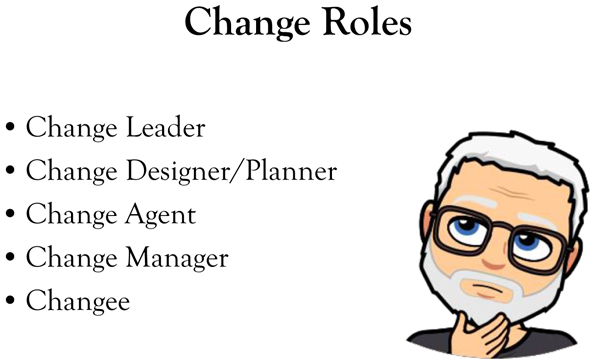Concept
There are many roles that occur in the change process. We can name at least the following:
1. Change Leader
2. Change Designer
3. Change Agent
4. Change Manager
5. Changee
Change leaders see the pain, envision the need, and start things rolling. Change designers lay out the plan, the process, the mechanisms for making the change. Change agents organize and begin the change program in part by assembling a change team. Change managers are the people in the middle of the effort, experiencing and executing the change process. Frequently, change managers are reacting to the requests or directions of the change agents. Changees are the people who are affected by and must adapt to the elements of the change process.
People can be in several of these roles, perhaps even all of them. An awareness of the different functional roles in the change process can help designers ensure they have the right people involved. In top down change efforts, senior executives are the change leaders, internal consultants or senior level managers play the role of change designers, and lines of business (LOB) managers become the managers of the change process.
Example
C-level executives reviewing periodic reports identify a variance from plan. They decide something needs to be done to rectify the results emerging from the organization. They hire consultants or bring in internal consultants from their organizational development department or human resources department to help them design the change effort. Once the program is designed, the plan is rolled out to the in-line LOB leaders for implementation; their job is to make it happen. Those reporting the LOB leaders are tasked with implementing the program. The people reporting to them find themselves having to change their daily routines and activities to fit into the requests.
In a mid-level or lower-level model, as suggested by Senge, a few employees with initiative see a need and begin to design a fix. They may seek guidance or simply go about designing and making changes without involving senior management.
The organization’s control systems and resulting culture will determine whether and how often mid and lower level change efforts pop up.
Diagram

Challenge
1. Which change roles have you played in your career?
2. How should Change Leaders think about the other roles?
3. Who ensures the success of any change effort?
4. What are the skills associated with each role?
